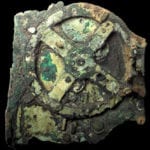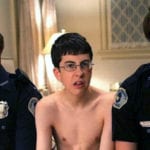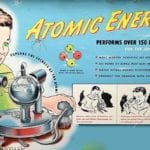 Mysteries
Mysteries  Mysteries
Mysteries  History
History 10 Surprising Stories About the Texas Rangers
 Humans
Humans 10 Philosophers Who Were Driven Mad by Their Own Theories
 Miscellaneous
Miscellaneous 10 Video-Game-Worthy Weapons and Armors from History
 Weird Stuff
Weird Stuff 10 Psychics Who Accurately Predicted Wartime Events
 The Arts
The Arts 10 Pieces of Art Inspired by a Broken Heart
 Health
Health 10 Science Fiction-Sounding New Medical Treatments
 History
History 10 Surprising Facts About the Father of Submarine Warfare
 Space
Space Ten Astonishing New Insights into Alien Worlds
 Weird Stuff
Weird Stuff 10 Bizarre Summer Solstice Rituals Still Practiced Today
 Mysteries
Mysteries Top 10 Haunting Facts About the Ghost Ship MV Alta
 History
History 10 Surprising Stories About the Texas Rangers
 Humans
Humans 10 Philosophers Who Were Driven Mad by Their Own Theories
Who's Behind Listverse?

Jamie Frater
Head Editor
Jamie founded Listverse due to an insatiable desire to share fascinating, obscure, and bizarre facts. He has been a guest speaker on numerous national radio and television stations and is a five time published author.
More About Us Miscellaneous
Miscellaneous 10 Video-Game-Worthy Weapons and Armors from History
 Weird Stuff
Weird Stuff 10 Psychics Who Accurately Predicted Wartime Events
 The Arts
The Arts 10 Pieces of Art Inspired by a Broken Heart
 Health
Health 10 Science Fiction-Sounding New Medical Treatments
 History
History 10 Surprising Facts About the Father of Submarine Warfare
 Space
Space Ten Astonishing New Insights into Alien Worlds
 Weird Stuff
Weird Stuff 10 Bizarre Summer Solstice Rituals Still Practiced Today
10 Movies That Were Ahead of Their Time
Over the years, many filmmakers have tried to break the mold and do something new. Only the best have created something that has left its mark on the entertainment industry and society.
Here, we’ll focus on movies with a human cast, so, unfortunately, there is no room for animation. We’ve chosen the listed movies because they had at least one characteristic that made them stand out to influence future writers, directors, and actors. Unfortunately, some worthy candidates had to be left out because of the need to prepare only a list of ten. So, for now, here are 10 movies that were ahead of their time.
Related: Top 10 Ways Hollywood Recycles Movies
10 The Birth of a Nation (1915)
Nowadays, many people won’t watch The Birth of a Nation due to its hatred and treatment of Black people. Originally called The Clansman, the movie sees the Ku Klux Klan as a force for good in American society. In the film, the Klan was portrayed as protecting American values and women, keeping Black citizens in their place.
As expected, and rightfully so, The NAACP organized protests at theaters, and many critics were disturbed by the film’s narrative. Even so, the film was hugely successful.
Directed by D.W. Griffith (1875–1948), the film broke new ground in many ways. First, it was a very long movie for the time period, running over three hours long. Second, it introduced the use of close-ups and fadeouts; it was called “The World’s Mightiest Spectacle.” Considering the movie came out in 1915, it was technically far ahead of anything else.
9 Ecstasy (1933)
Hedwig Kiesler, soon to be known in Hollywood as Hedy Lamarr (1914–2000), was 18 when Czech director Gustav Kiesler cast her as the female lead in Ecstasy. The story is common enough—a young woman trapped in a loveless marriage with an older man who takes a lover.
What was startling was the fact that the film depicted sexual intercourse and showed Lamarr in the throes of orgasm. Only pornographic films had ever done such a thing before. In Europe, critics said that the movie was artistic. In the United States, it was banned.
As a side note, and with nothing to do with Ecstasy, I can’t resist mentioning that Lamarr was also a genius. During the Second World War, she took time off selling war bonds to work on the enemy’s ability to jam radio torpedoes.
Despite having no professional training, she worked on frequency-hopping technology with a pianist and a radio-electrical engineer. The U.S. Navy didn’t adopt her system, but some of her insights are used today in Bluetooth and GPS technology. She is in the National Inventors Hall of Fame.
8 The Wizard of Oz (1939)
Usually, analysts measure a movie’s success by how much it grossed at the box office. This isn’t surprising because movies are commercial ventures. But knowing the number of people who paid to see a film can’t tell us if the film is any good or not. Its success might be down to good marketing, or it might be popular with kids but not adults.
In 2018, researchers at the University of Turin used a different measurement. Using a database of 47,000 movies, they looked at how many times a film mentioned another film. The clear winner was The Wizard of Oz.
L. Frank Baum’s original novel came out in 1900. Generally, people thought of it as a children’s story, but some read it as an allegory dealing with current problems. When the film hit theaters in 1939, cinemagoers saw the same ambiguity. On one level, it could be seen as an adventure for children; on another, it reflects American difficulties at the time. The movie operates on both levels, and filmmakers have been trying to recapture its magic ever since.
7 Citizen Kane (1941)
Many people will claim that Citizen Kane is the best movie of all time. Orson Welles produced, directed, and starred in the film, and much of its technical and narrative brilliance is down to his vision. Critics and industry insiders loved the film and nominated it for nine Academy Awards. However, it wasn’t an immediate box office hit.
At the time, most movies followed a simple narrative. They began at the beginning and trotted along to the end of the story ninety minutes later. This movie was different. It told Charles Foster Kane’s story from various viewpoints and moved backward and forward in time. It demanded its audience’s attention, and a movie-goer could watch it multiple times and get something new out of it every time. You can see its influence on movies such as Pulp Fiction.
The cinematography contributed much to the movie’s success. Gregg Toland used various unusual techniques to add visual depth to the storyline.
6 Psycho (1960)
Alfred Hitchcock’s 1960 masterpiece still has the power to frighten an audience today. Cinemagoers settling in to watch the film might have assumed that the story would focus on the embezzler, Marion. But this was a red herring. Hitchcock said, “They thought the story was about a girl who stole $40,000. And suddenly, out of the blue, she is stabbed to death.”
We know that the unfortunate Marion had fled to Norman Bates’s motel. Bates stabs her in the infamous shower scene early on, and the hunt for an embezzler becomes a psychological horror film. The fact that Marion was a thief is incidental; she could have been a hairdresser.
The shower scene shows the care that Hitchcock invested in the movie. It has 90 different breaks in around 45 seconds as the camera quickly switches from one angle to another. It’s a tense, tightly-focused movie that other moviemakers have tried to emulate—usually failing to do so.
5 Jaws (1975)
This classic emerged in 1975 before computer-generated imagery could help with special effects. The tension builds throughout the movie, mainly because we don’t get a good look at the shark until about halfway in. Yet this was accidental; the props were waterlogged and unusable, so director Steven Spielberg made do with shots of just the shark’s fin.
The film launched Spielberg’s career—he was only 26 when he directed Jaws and was fairly inexperienced. Perhaps his relative youth meant he could take a new approach and get away with it.
Everything about the movie was just about perfect. The cast, the music, the building tension, and the tight storyline combine to make a classic film. How influential Jaws was can be seen in the number of movies that have copied the idea. Similar plotlines with similar characters appear repeatedly, but none quite recapture Jaws’s tension and iconic nature.
4 Bonnie and Clyde (1967)
French New Wave cinema had a significant influence on Bonnie and Clyde. In its turn, Bonnie and Clyde had a great influence on Hollywood. This 1967 movie was directed by Arthur Penn and starred Faye Dunaway and Warren Beatty with a strong supporting cast.
So what made Bonnie and Clyde stand out from the hundreds, perhaps thousands, of Hollywood movies about depression-era gangsters? The answer lies in the embellishment of a true story. The film tossed convention aside and glorified sex and violence.
In this film, the gangsters are not shown as simply bad people. They are depicted as morally ambiguous, with a depth to their character that other films in the same genre didn’t reveal. It’s a stance that other filmmakers were to copy again and again. Perhaps one of the best examples is Quentin Tarantino.
3 Pulp Fiction (1994)
It’s not unusual to find a film that ends where it begins. Most of the movie then consists in explaining how the characters got there. The restaurant scene in Pulp Fiction frames the rest of the movie; it’s true. But the moment when Pumpkin and Honey Bunny try to hold up a diner where a tired Jules and Vincent are in no mood to give in to a pair of street hoodlums is not the beginning nor the end of the story.
Quentin Tarantino has created a movie that shifts from story to story, leaves questions unanswered (What exactly is in the briefcase?), and uses well-crafted, often funny dialogue that seems incidental to the plot but actually draws us along and gives the characters greater depth.
It’s a film that demands a lot from its audience. Only Tarantino could have made it work as well as it does.
2 Star Wars (1977)
Only 42 theaters showed the first Star Wars movie when it came out in 1977. Since then, George Lucas has built a phenomenal empire of his own.
The opening crawl sequence of the original movie begins with the line: “A long time ago in a galaxy far, far away..” This opening scene is one iconic key to Star Wars’ success and a move many other filmmakers have copied. In setting his story in a new galaxy, George Lucas had given himself the opportunity to invent a series of interlocking histories with limitless plotlines.
The first movie is beautifully made and directed. It has a strong storyline and a great cast. But Lucas saw the opportunity to create a franchise and sell merchandise that many others have copied—but none with his amazing success.
1 2001: A Space Odyssey (1968)
Stanley Kubrick’s 2001: A Space Odyssey is a visual masterpiece. The long opening sequence that shows apes discovering an extra-terrestrial sentry has only grunts as dialogue. Even when modern humans appear on the scene, their conversation adds nothing to the storyline. It is a movie to watch rather than listen to.
Kubrick, and his special-effects man, Douglas Trumball, borrowed technology from wherever they could find it and introduced innovative new ideas of their own. The result is a film that is stunning to watch, and that has stood the test of time. Indeed, it’s still as fresh today as when it came out in 1968, well over 50 years ago.
To make such a compelling movie without the benefit of modern technology is a work of genius.








